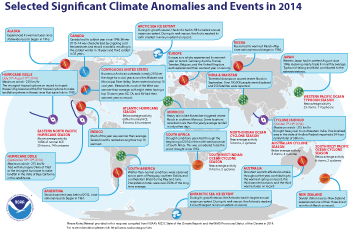Re: 2014: Hottest Year in Recorded Human History
Posted by hanna on 1/18/2015, 1:00 pm
| http://www.ncdc.noaa.gov/sotc/summary-info/global/2014/12 December 2014 record warm; Global oceans also record warm for 2014 The globally averaged temperature over land and ocean surfaces for 2014 was the highest among all years since record keeping began in 1880. The December combined global land and ocean average surface temperature was also the highest on record.   Global highlights: Calendar Year 2014 For extended analysis of global climate patterns, please see our full Annual report During 2014, the average temperature across global land and ocean surfaces was 1.24°F (0.69°C) above the 20th century average. This was the highest among all 135 years in the 1880-2014 record, surpassing the previous records of 2005 and 2010 by 0.07°F (0.04°C). Record warmth was spread around the world, including Far East Russia into western Alaska, the western United States, parts of interior South America, most of Europe stretching into northern Africa, parts of eastern and western coastal Australia, much of the northeastern Pacific around the Gulf of Alaska, the central to western equatorial Pacific, large swaths of northwestern and southeastern Atlantic, most of the Norwegian Sea, and parts of the central to southern Indian Ocean. During 2014, the globally-averaged land surface temperature was 1.80°F (1.00°C) above the 20th century average. This was the fourth highest among all years in the 1880-2014 record. During 2014, the globally-averaged sea surface temperature was 1.03°F (0.57°C) above the 20th century average. This was the highest among all years in the 1880-2014 record, surpassing the previous records of 1998 and 2003 by 0.09°F (0.05°C).  Looking above Earth's surface at certain layers of the atmosphere, two different analyses examined NOAA satellite-based data records for the lower and middle troposphere and the lower stratosphere. The 2014 temperature for the lower troposphere (roughly the lowest five miles of the atmosphere) was third highest in the 1979-2014 record, at 0.50°F (0.28°C) above the 1981-2010 average, as analyzed by the University of Alabama Huntsville (UAH), and sixth highest on record, at 0.29°F (0.16°C) above the 1981-2010 average, as analyzed by Remote Sensing Systems (RSS). The 2014 temperature for the mid-troposphere (roughly two miles to six miles above the surface) was third highest in the 1979-2014 record, at 0.32°F (0.18°C) above the 1981-2010 average, as analyzed by UAH, and sixth highest on record, at 0.25°F (0.14°C) above the 1981-2010 average, as analyzed by RSS. The temperature for the lower stratosphere (roughly 10 miles to 13 miles above the surface) was 13th lowest in the 1979-2014 record, at 0.56°F (0.31°C) below the 1981-2010 average, as analyzed by UAH, and also 13th lowest on record, at 0.41°F (0.23°C) below the 1981-2010 average, as analyzed by RSS. The stratospheric temperature is decreasing on average while the lower and middle troposphere temperatures are increasing on average, consistent with expectations in a greenhouse-warmed world. According to data from NOAA analyzed by the Rutgers Global Snow Lab, the average annual Northern Hemisphere snow cover extent during 2014 was 24.95 million square miles, and near the middle of the historical record. The first half of 2014 saw generally below-normal snow cover extent, with above-average coverage later in the year. Recent polar sea ice extent trends continued in 2014. The average annual sea ice extent in the Arctic was 10.99 million square miles, the sixth smallest annual value of the 36-year period of record. The annual Antarctic sea ice extent was record large for the second consecutive year, at 13.08 million square miles. Global highlights: December 2014 During December, the average temperature across global land and ocean surfaces was 1.39°F (0.77°C) above the 20th century average. This was the highest for December in the 1880-2014 record, surpassing the previous record of 2006 by 0.04°F (0.02°C). During December, the globally-averaged land surface temperature was 2.45°F (1.36°C) above the 20th century average. This was the third highest for December in the 1880-2014 record.  During December, the globally-averaged land surface temperature was 2.45°F (1.36°C) above the 20th century average. This was the third highest for December in the 1880-2014 record. The average Arctic sea ice extent for December was 210,000 square miles (4.1 percent) below the 1981-2010 average. This was the ninth smallest December extent since records began in 1979, according to analysis by the National Snow and Ice Data Center based on data from NOAA and NASA. Antarctic sea ice during December was 430,000 square miles (9.9 percent) above the 1981-2010 average. This was the fourth largest December Antarctic sea ice extent on record. According to data from NOAA analyzed by the Rutgers Global Snow Lab, the Northern Hemisphere snow cover extent during December was 130,000 square miles below the 1981-2010. This was the 20th smallest December Northern Hemisphere snow cover extent in the 49-year period of record. For extended analysis of global temperature and precipitation patterns, please see our full December report |
152
In this thread:
2014: Hottest Year in Recorded Human History - cypresstx, 1/17/2015, 2:49 pm
- Re: 2014: Hottest Year in Recorded Human History - hanna, 1/18/2015, 1:00 pm
< Return to the front page of the: message board | monthly archive this page is in
Post A Reply
This thread has been archived and can no longer receive replies.